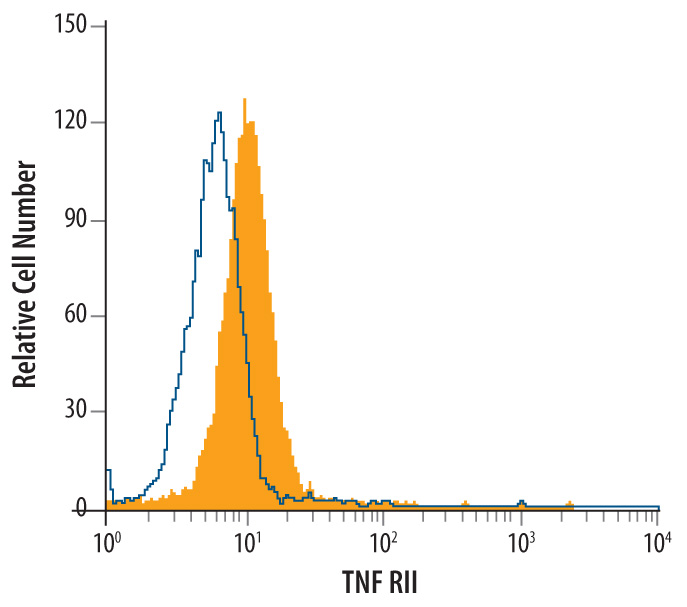Mouse TNF RII/TNFRSF1B Antibody Summary
Extracellular domain
Applications
Mouse TNF RII/TNFRSF1B Sandwich Immunoassay
Please Note: Optimal dilutions should be determined by each laboratory for each application. General Protocols are available in the Technical Information section on our website.
Scientific Data
 View Larger
View Larger
Detection of TNF RII/TNFRSF1B in L‑929 Mouse Cell Line by Flow Cytometry. L-929 mouse fibroblast cell line was stained with Hamster Anti-Mouse TNF RII/ TNFRSF1B Monoclonal Antibody (Catalog # MAB426, filled histogram) or isotype control antibody (open histogram), followed by Phycoerythrin-conjugated Anti-Hamster IgG Secondary Antibody (Catalog # F0120).
Reconstitution Calculator
Preparation and Storage
- 12 months from date of receipt, -20 to -70 °C as supplied.
- 1 month, 2 to 8 °C under sterile conditions after reconstitution.
- 6 months, -20 to -70 °C under sterile conditions after reconstitution.
Background: TNF RII/TNFRSF1B
Two types of soluble TNF receptors have been identified in human serum and urine which can neutralize the biological activities of TNF-alpha and TNF-beta. These binding proteins represent truncated forms of the two types of high-affinity cell surface receptors for TNF (TNFR-p60 Type B and TNFR-p80 Type A). Soluble TNF RII corresponds to TNFR-p80 Type A. In the new TNF superfamily nomenclature, TNF RII is referred to as TNFRSF1B. These apparent soluble forms of the receptors appear to arise as a result of shedding of the extracellular domains of the membrane-bound receptors. Normal concentrations as high as 4 ng/mL are found in the serum of healthy individuals, and even higher levels may be found in some pathological conditions. Although the physiological role of these proteins is not known, it has been speculated that shedding of the soluble receptors in response to TNF release could serve as a mechanism to scavenge the TNF not immediately bound and thus localize the inflammatory response. It is also possible that the pool of TNF bound to soluble receptors could represent a reservoir for the controlled release of TNF.
Product Datasheets
Citations for Mouse TNF RII/TNFRSF1B Antibody
R&D Systems personnel manually curate a database that contains references using R&D Systems products. The data collected includes not only links to publications in PubMed, but also provides information about sample types, species, and experimental conditions.
4
Citations: Showing 1 - 4
Filter your results:
Filter by:
-
Activated CD8+ T cells induce expansion of Vbeta5+ regulatory T cells via TNFR2 signaling.
Authors: Joedicke J, Myers L, Carmody A, Messer R, Wajant H, Lang K, Lang P, Mak T, Hasenkrug K, Dittmer U
J Immunol, 2014-08-06;193(6):2952-60.
Species: Mouse
Sample Types: Whole Cells
Applications: Flow Cytometry -
Circulating cytokine/inhibitor profiles reshape the understanding of the SIRS/CARS continuum in sepsis and predict mortality.
Authors: Osuchowski MF, Welch K, Siddiqui J, Remick DG
J. Immunol., 2006-08-01;177(3):1967-74.
Species: Mouse
Sample Types: Plasma
Applications: ELISA Development -
Sequential ELISA to profile multiple cytokines from small volumes.
Authors: Osuchowski MF, Siddiqui J, Copeland S, Remick DG
J. Immunol. Methods, 2005-07-01;302(1):172-81.
Species: Mouse
Sample Types: Plasma
Applications: ELISA Development -
Selective macrophage suppression during sepsis.
Authors: Ellaban E, Bolgos G, Remick D
Cell. Immunol., 2005-02-26;231(1):103-11.
Species: Mouse
Sample Types: Cell Culture Supernates
Applications: ELISA Development
FAQs
No product specific FAQs exist for this product, however you may
View all Antibody FAQsReviews for Mouse TNF RII/TNFRSF1B Antibody
There are currently no reviews for this product. Be the first to review Mouse TNF RII/TNFRSF1B Antibody and earn rewards!
Have you used Mouse TNF RII/TNFRSF1B Antibody?
Submit a review and receive an Amazon gift card.
$25/€18/£15/$25CAN/¥75 Yuan/¥2500 Yen for a review with an image
$10/€7/£6/$10 CAD/¥70 Yuan/¥1110 Yen for a review without an image





